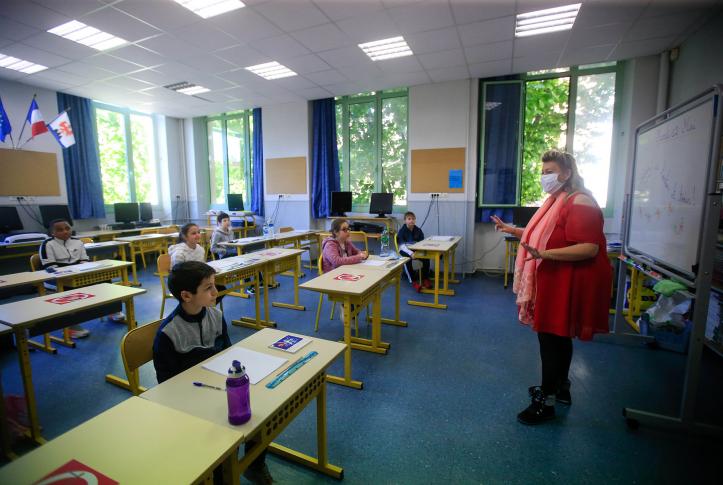By the beginning of April, 185 countries had shut down their schools because of COVID-19, affecting 89 percent of the world’s children. Many developed countries have since reopened schools without experiencing significant outbreaks of the coronavirus. U.S. policymakers and school leaders can take into account what these countries have done as they consider whether and how to reopen schools.
Earlier this year, the Bipartisan Policy Center (BPC) analyzed international approaches to loosening social distancing interventions — including those from Austria, China, Czech Republic, Denmark, France, Germany, Hong Kong, Italy, Netherlands, Singapore, South Korea, Spain, Switzerland, Taiwan, and the United Kingdom — to gather recommendations for the United States. When selecting countries, BPC considered such criteria as the availability of data and effectiveness of the interventions based on preliminary results.
Current evidence shows that children are at lower risk of severe illness or death from COVID-19 than adults. However, there are still unanswered questions regarding viral transmissibility and risk of infection once exposed. A recent study found children younger than age 10 are less likely than adults to transmit the virus, while older children may transmit it at levels similar to adults.
In addition, time spent away from in-person classes, particularly for younger students, can lead to academic regression as well as reduced access to critical services, such as school meals, that could have short- and long-term effects. School employees also play an essential part in identifying cases of child neglect and abuse; about 20 percent of cases are reported by school staff. Evidence suggests that incidents of child abuse and neglect have increased since the pandemic.
Consistent with these findings, a recent report from the National Academies of Sciences, Engineering, and Medicine urges school districts to prioritize safely reopening schools full time, especially for kindergarten through grade 5 and for students with special needs.
Containing the Virus
Evidence from other countries suggests that the most important factor to successful reopening is a low baseline rate of community transmission. A recent study found that compared with a range of countries that had reopened schools, the U.S. currently has significantly higher numbers of daily cases, cases per million population, and positivity rates. Updated Centers for Disease Control and Prevention (CDC) guidelines suggest low community transmission as a necessary prerequisite to safely reopen schools.
As an example, leaders in the Netherlands began to consider reopening schools only after seeing a steady decline in new cases. The Dutch government closed schools in anticipation of the first wave on March 16. At its peak, in mid-April, the Netherlands saw 1,300 daily cases. By May, when elementary schools began to reopen, the country’s daily cases had dropped significantly, to 161. So far, the Netherlands has not seen an increase in cases linked to reopened schools.
Norway and other countries have implemented mandatory contact tracing of confirmed cases to help assess when to safely reopen schools. Unfortunately, uncontrolled spread in many regions of the U.S., combined with delays in obtaining test results, have made it extremely difficult to perform contact tracing to break chains of transmission.
Plans for Safe Reopening
Successful school reopening also requires plans and policies that support evidence-informed measures like physical distancing, hand-washing, use of masks, and environmental cleaning.
Physical distancing in and out of the classroom is common practice across the countries we studied. Schools in Switzerland use tape on floors to mark adequate space between desks. To further limit contact, many Swiss schools reduced class sizes by 50 percent.
Another method of physical separation involves use of “bubbles,” or small groups. Students in Denmark are organized in groups of 12, known as “protective bubbles.” These groups eat lunch separately and have their own playground areas. Bubbles have allowed school and health officials to quickly isolate groups of students who may have been exposed without disrupting the entire school. The CDC points to bubbles as a potential strategy for U.S. schools.
Many schools also are incorporating staggered schedules to eliminate crowding. In Japan, students attend class on alternating days to limit the number of students at any given time. Some German schools took a similar approach; students attend in-person class one day, then take classes online the next.
It is too early to tell the extent to which these strategies reduce transmission of the coronavirus, but all the countries we studied have been successful in keeping schools open thus far. In contrast, Israel opened its schools to all students, and soon after lifted limits on class sizes and requirements to wear masks. Subsequent outbreaks led to school reclosures and community spread.
Certain interventions require additional research. Some countries require routine coronavirus testing for students to attend in-person classes. In some German states, students are tested every four days. This is not an option everywhere, as tests can be expensive. Singapore and Japan rely on daily temperature checks, although fever is not always a COVID-19 symptom among children. Current CDC guidance recommends screening children prior to school arrival, which involves either parents or staff taking their temperatures.
Support for Schools
Many countries have prioritized the school sector in their recovery plans and involved teachers in the decision-making process. Cost estimates to support U.S. schools in retrofitting facilities and stockpiling equipment range from $20 billion from the Council on School Facilities to $116 billion from the American Federation of Teachers.
While the CARES Act provided some money to expand broadband access, schools in the U.S. have otherwise received limited support from Congress. The HEROES Act, passed by the House on May 15, would provide $58 billion to K–12 schools; a Senate Democratic bill would provide $175 billion, and the recently proposed Senate Republican bill would provide $70 billion. Bipartisan agreement on a school support package would give schools the best chance to safely reopen without outbreaks.
